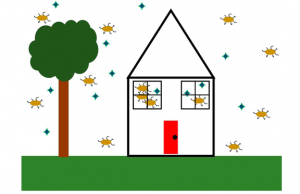Of potential interest: BMC Infectious Diseases | The airborne microbiome – implications for aerosol transmission and infection control From the site Edited by Julian Tang, University Hospitals Of Leicester NHS Trust, UK & Yuguo Li, University of Hong Kong, Hong Kong Many infectious diseases, such as tuberculosis, whooping cough, Aspergillus and other fungal infections, human and avian influenza, measles, chickenpox, and some …
In the world of built environment (BE) microbiome research, we are by now well aware that building designs have influences on the indoor microbial assemblage. Therefore, BEs that employ a multitude of innovative designs, such as green and zero carbon buildings (GBs and ZCBs), may provide us greater insight on the mechanistic basis for …
Researchers at Virginia Tech’s Center for Science and Engineering of the Exposome (SEE) recently published a critical review in ES&T examining the “exposome of the built environment” and proposed engineering strategies for its control. The exposome is defined as our lifetime exposure to chemicals, microbes, and radiation and derives from anything we come into …
Just a quick post here. Another story on Legionnaires Disease. This time the bacteria behind it was found in the NY Police Station. Source: Bacteria Behind Legionnaires’ Disease Found at New York Police Station – The New York Times From the article Traces of the bacteria that cause Legionnaires’ disease have been found in the water …
Microbes indoors DNA metabarcoding to assess indoor fungal communities: Electrostatic dust collectors and Illumina sequencing – Steffi Rocchi – Journal of Microbiological Methods ($39.95) Our study aimed to evaluate metabarcoding and bioinformatic analysis resulting from calibrated samples and samples collected by an electrostatic dust collector (EDC) in dwellings with no moisture problems. Thus, the fungal communities of …
(Thanks to Paula Olsiewski for passing on this information from the EPA) Dear Stakeholder, Consistent with Executive Order 13777, the U.S. Environmental Protection Agency’s (EPA) Office of Air and Radiation (OAR) is hosting a public teleconference on April 24, 2017, from 11:00 a.m. to 2:00 p.m. EDT to solicit input on specific air and radiation …
. The Biology and the Built Environment Center (BioBE) and Energy Studies in Buildings Laboratory (ESBL) at the University of Oregon, are pleased to announce the launch of the the Health + Energy Research Consortium! On May 4-5, 2017, in Portland Oregon, we begin our journey to dramatically reduce energy consumption and maximize human health …
Kevin Van Den Wymelenberg and Jessica Green, of the Biology and the Built Environment Center (BioBE), are currently seeking a microbial ecology Research Associate / Research Assistant Professor / Research Associate Professor (non-tenure track faculty) to investigate fundamental questions surrounding the role of microorganisms (bacteria, archaea, fungi, protists, and viruses) in the built environment and …
New RFA for 2018–2020 now available! Closing Date: February 17, 2017Request for Applications (RFA): “National Indoor Environments Program: Reducing Public Exposure to Indoor Pollutants”U.S. EPA’s Office of Air and Radiation (OAR), Indoor Environments Division (IED) has posted a new RFA (EPA-OAR-ORIA-17-02) here, www.epa.gov/grants/air-grants-and-funding, and here, www.grants.gov/web/grants/view-opportunity.html?oppId=290725. EPA expects to make between 10 and 20 awards. …
Studying the 5 second rule, antibiotic resistance genes in indoor dust and sewers, Legionella in the air, and water treatment. Microbes on the floor Longer Contact Times Increase Cross-Contamination of Enterobacter aerogenes from Surfaces to Food — Robyn C. Miranda — Applied and Environmental Microbiology ($25 for 1 day) Bacterial cross-contamination from surfaces to food can …









